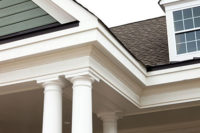For example, metal framing is no longer in Division 5 but in Division 05. This may seem like a minor change but always writing the place holding zero makes a big difference when using computerized databases to design, bid or manage a construction project. Coping with the expanding use of computers in construction is just one of reasons for revising MasterFormat.
Other reasons include:
Accommodate types of construction work that did not exist when the MasterFormat was originally created, like cabling system for intelligent buildings.
• Expand MasterFormat to make it easier to use in all types of construction and not just architectural projects.
• Create a system that could be used throughout a project's lifecycle, including renovation and maintenance work.
What the numbers mean
To meet these objectives, MasterFormat has been expanded from 16 divisions to 50. Section numbers have been increased from five-digit numbers to six digits with options for up to four additional digits when greater specificity is required.Section numbers for framing will still look somewhat familiar, although some section titles have been changed for greater consistency with emerging industry terminology and international standards for indexing. For example:
Old 05410 Load-Bearing Metal Studs
New 05 41 00 Structural Metal Stud Framing
Old 05420 Cold-Formed Metal Joists
New 05 42 00 Cold-Formed Metal Joist Framing
05 42 13 Cold-Formed Metal Floor Joist Framing
05 42 23 Cold-Formed Metal Roof Joist Framing
New sections have been added in recognition of industry developments,
for example:
05 44 00 Cold-Formed Metal Trusses.
However, other types of work that impact framing have significantly different section numbers now. For example:
Old 15060 Hangers and Supports
New 22 05 29 Hangers and Supports for Plumbing Piping and Equipment
Make the Transition
In the short run, these and the other changes in MasterFormat may be a minor nuisance. In the long run, however, the new standard improves the efficiency of the construction industry and provides enough flexibility to meet future demands. This viewpoint has been embraced by major players in the construction industry.For example, the U.S. Department of Defense has adopted MasterFormat 2004 for its new construction projects. Moreover, R. S. Means, Timberline, Sweets, MasterSpec and other major publishers of construction information systems are in the process of implementing the new MasterFormat numbers and section titles.
Many framing system manufacturers are also in the process of updating their product literature and training their sales representatives to use the new numbers. Manufacturers can go to www.chusid.com/masterformat.htm for tips on how they can use the changes to MasterFormat to improve their customer service and sales and marketing programs.
Framing contractors should make sure that their estimators and project managers are aware of the new numbers so they are not caught off guard the first time they bid a project under the new numbers.
Information about obtaining a copy of MasterFormat 2004 and other useful transition resources are available at www.csinet.org/masterformat. Many CSI chapters will be conducting workshops this year to help the industry get up to speed.
Another way to learn about the changes to MasterFormat and make a sales call at the same time, is to take your favorite specifier out to lunch; that's one number everybody can enjoy.

